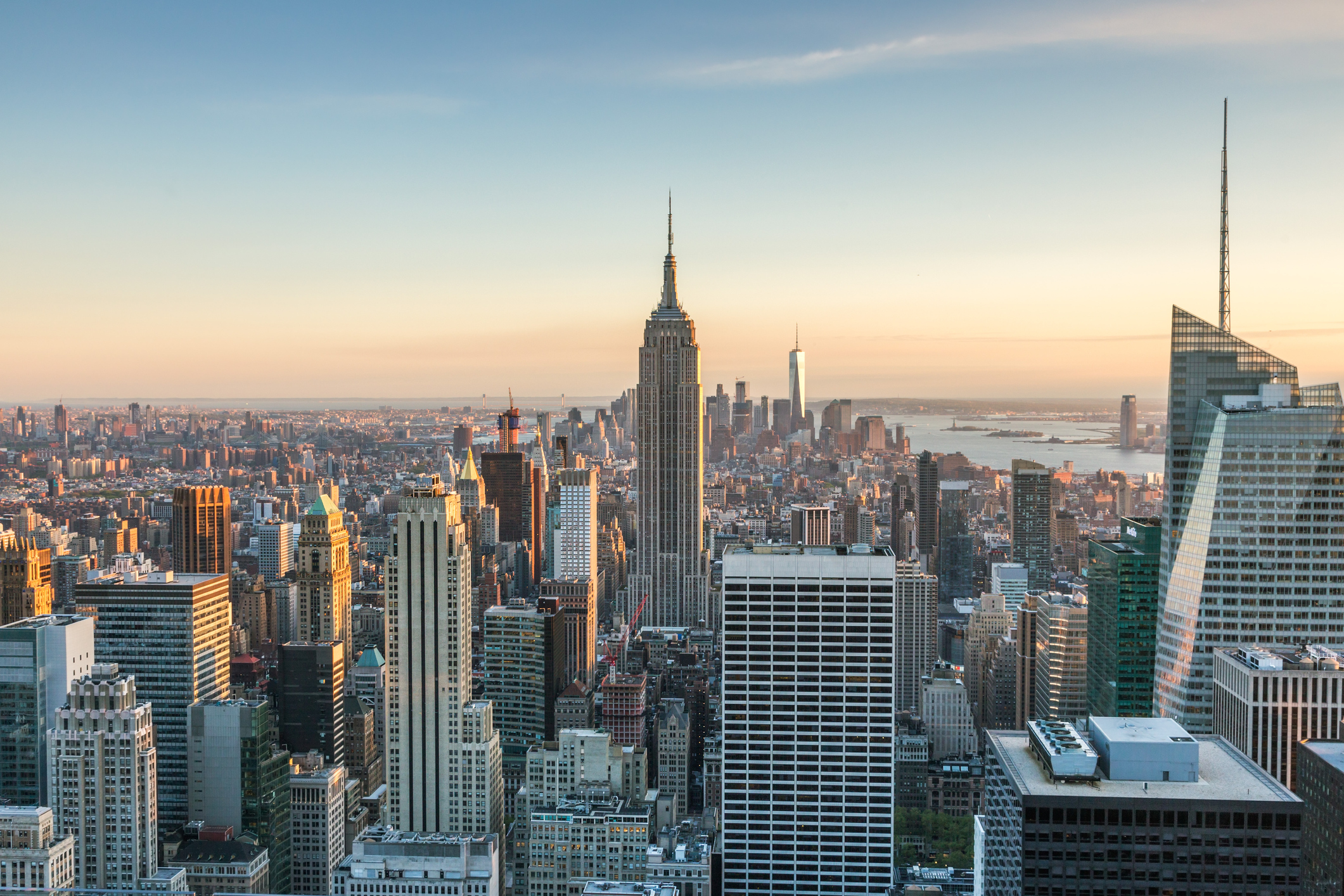How to Make Sense of New York’s Confusing Luxury Home Market
From where the big deals are happening to new condo inventory, here’s everything you need to know about what’s happening at the high end
On Central Park South, retired entrepreneur Ron Pobuda has relisted his two-bedroom apartment for $8.95 million, a dramatic 40% reduction from its first asking price in Sept. 2020. Twenty blocks north, on the Upper East Side, real-estate agent James Morgan found a buyer for an $18 million penthouse before he could even get the property listed online.
In the wake of the Covid pandemic and interest-rate hikes—and amid an AI-driven stock market climb—buyers and sellers are having a hard time deciphering the New York City luxury real-estate market.
Ask a broker in Miami and they’ll say New York is dead. Ask a residential tower developer in New York, they’ll say that is nonsense. Ask a local real-estate agent, and he’ll say the market has rarely felt so hit-or-miss.
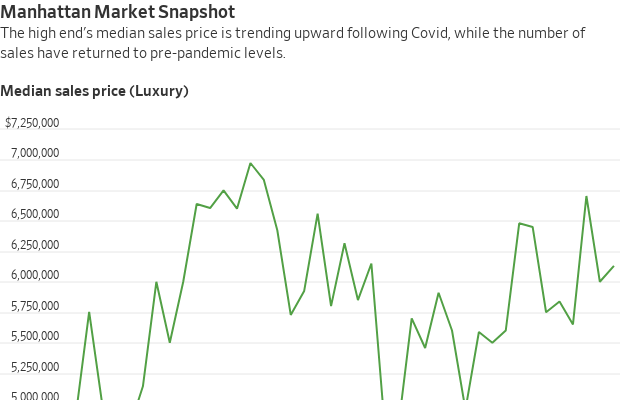
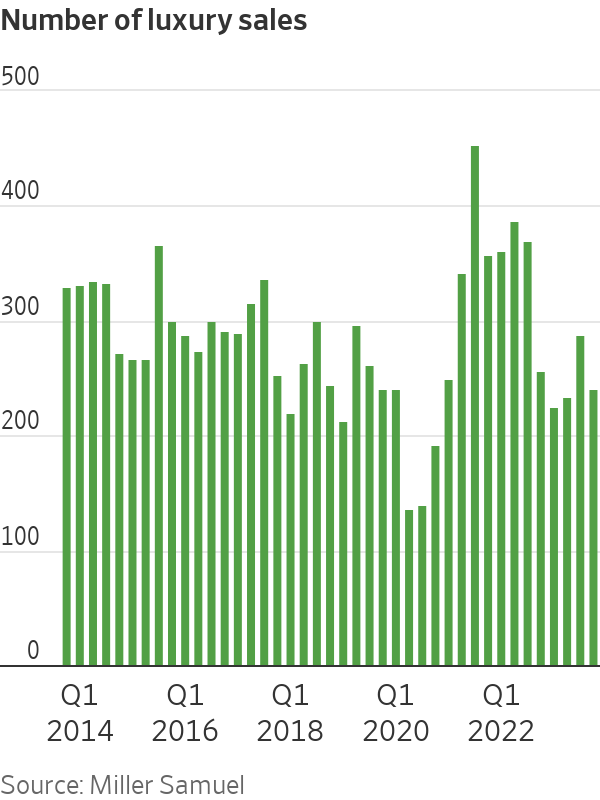
“It’s a mixed bag. Some things sell in two days. Other things sit there for two years,” said Leonard Steinberg, a luxury real-estate agent with Compass .
The Manhattan numbers point to a post-Covid luxury market that likely bottomed out in 2023, said appraiser Jonathan Miller . A report he prepared for brokerage Douglas Elliman shows that, in the fourth quarter of 2023, sales of luxury Manhattan homes (defined by the report as the top 10% of all sales ) were down by 5.9% compared with the same period a year prior.
It seems to be improving. So far in 2024, luxury contract activity has ticked up incrementally, according to local agents, who cite a decrease in inventory and a rising stock market. Liquidity pace, a measure of the rolling previous 30 days of signed-contract volume, was up by 9% so far in 2024 through Feb. 26 for apartments priced at $5 million and up, compared with the same period last year, according to real-estate data firm UrbanDigs.
“It looks like 2024 will be better, but it won’t be a boom,” Miller said.
Thanks to higher interest rates, all-cash deals are dominating the market, with roughly 68% of all Manhattan transactions unfinanced in the fourth quarter, according to Miller. That is up from the usual average of around 50%, Miller said.
Here’s a closer look at New York’s contrary, confusing high-end property market.
Where the sales are
The sale of a roughly 12,000-square-foot Greenwich Village mansion owned by Dexter Goei , the former chief executive of telecommunications company Altice USA , set a new price record for Downtown Manhattan. (NYC brokers define Downtown as south of 34th Street. It is more commonly defined as south of 14th Street.) It traded off market for $72.5 million in January. The price was more than double the $30.9 million that Goei paid for it in 2016, records show.
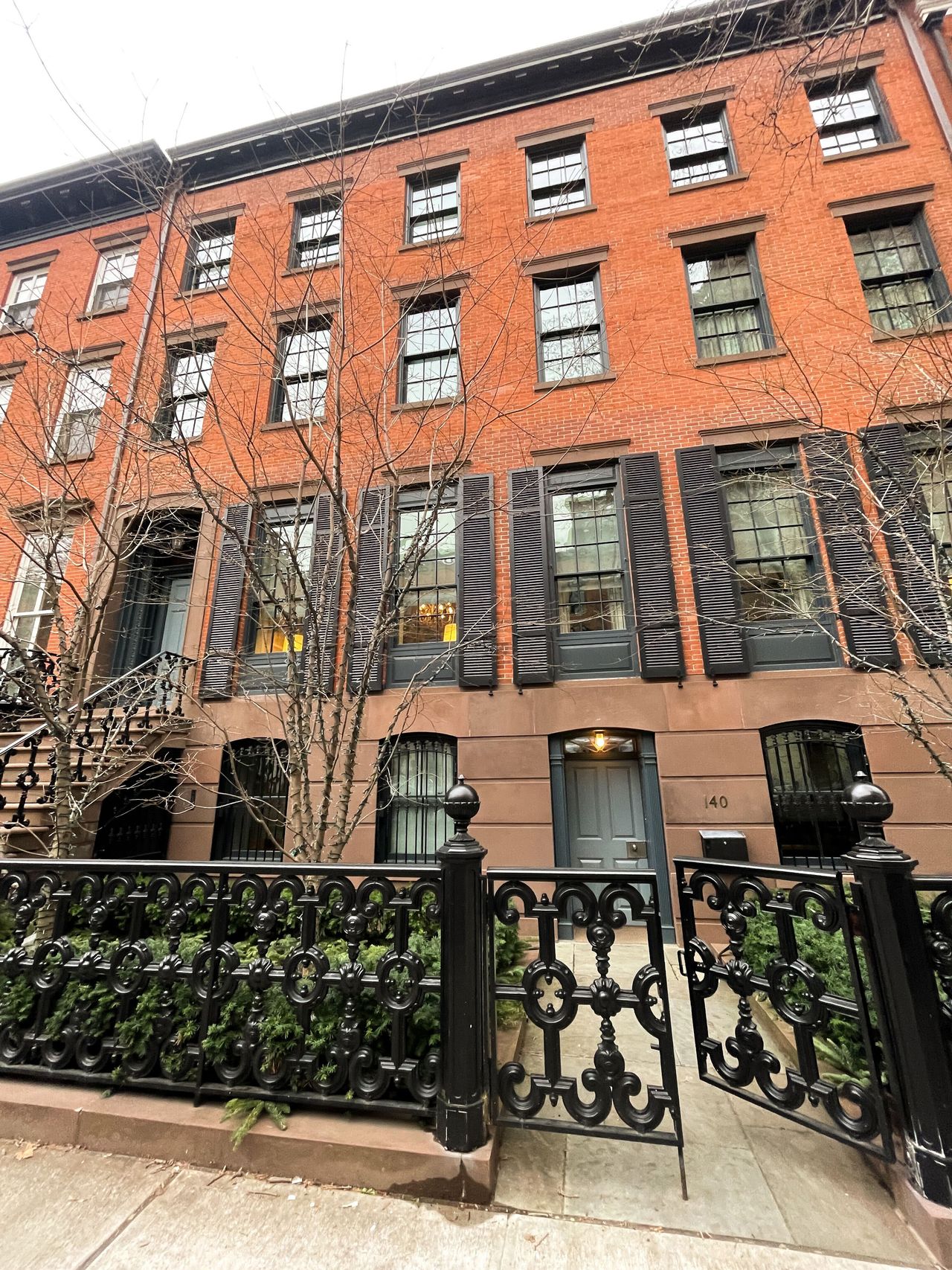
The deal added to a string of major Downtown transactions that propped up the Manhattan market in 2023. In July, a penthouse at 150 Charles Street, a successful West Village condominium project, sold for $52 million . The seller was a company tied to former Credit Suisse executive Robert Shafir . In June, a Soho penthouse tied to Stefan Kaluzny, managing director of the private-equity firm Sycamore Partners, sold for $50 million , one of the largest deals ever recorded in Soho.
Clayton Orrigo, who worked on the $72.5 million Greenwich Village deal, said his team at Compass has closed or signed contracts on more than $500 million in real estate since the beginning of the year, with about 80% located south of 30th Street, and he expects the Goei property to be the first of a handful of major house sales in the neighbourhood. Other major Downtown properties that have been shopped for sale at similarly ambitious price points in recent years include financier Steve Cohen’s fortresslike, single-family mansion on Perry Street, which is said to have asked around $150 million in off-market conversations.
“I do believe that it’s a pioneer,” Orrigo said of the $72.5 million deal, declining to confirm the identity of his clients. “I don’t think it’s the last and I don’t think it will be the most expensive.”
Orrigo attributed the rise of Downtown prices to a lack of available inventory. Sought-after Downtown neighbourhoods like Greenwich Village, the West Village and Tribeca don’t see the same levels of new development as other Manhattan neighbourhoods, thanks in large part to height restrictions tied to their designations as historic districts. He said many of his moneyed clients who visit the city eventually look to buy pieds-a-terre in the area because they are unsatisfied with the hotel offerings. Airbnb listings in New York City have also all but disappeared as the city cracks down on short-term rentals .
In addition to the city’s stepped-up enforcement of short-term rental rules, many condo and co-op boards don’t allow owners to rent their properties at all, even if the rental wouldn’t be subject to the city’s short-term rental regulations. “When they realise how hard it is, they end up buying,” Orrigo said.
Orrigo said the buyer pool is made up of tech titans and “the nepo community,” meaning the children of wealthy individuals. “We’re seeing a tremendous amount of inherited wealth,” he said.
Luxury agent Sarah Williams of Societe Real Estate said she recently had a client sign a $41,000 a month, long-term rental deal when they couldn’t find a home that met their criteria in the West Village or Tribeca.
“There’s this widespread misunderstanding about New York, that it’s struggling,” she said. “New York is so sought after, it’s just that people cannot get what they want.”
One of the most successful new condos of 2023 was also located Downtown at 450 Washington Street. A rental-to-condo conversion by the Related Companies, it posted roughly $240 million in sales across 85 transactions in 2023, the developer said. Units were priced between $1 million to $15 million for studio to four-bedroom homes. Bruce A. Beal Jr., Related’s president, said the project had the “right pricing” and that buyers, the majority of whom were local, “understood the product.”
Where it’s still tough to sell
While Downtown is thriving, Midtown has been hobbled by excess inventory, remote work and a decline in foreign buyers, who have historically gravitated toward Midtown apartments, agents said.
When Pobuda, the entrepreneur with the Central Park South apartment, listed his longtime unit, a sprawling two-bedroom with a large terrace overlooking the park, in late 2020, he first asked $15 million. While ambitious, the price reflected the property’s trophy views and location, next door to 220 Central Park South , the most expensive building in the city. He got no offers.
“It was really obvious very quickly that nothing was going to happen, so I said, ‘Let’s just pull it off the market.’ ” Pobuda said.
The new asking price is a reflection of how the market has moved in response to interest rates and is strategically pegged just under $10 million to put it in a different bracket for New York’s mansion tax, said Peter McLean of the Corcoran Group, who is listing Pobuda’s unit. “We’re throwing as many incentives to the buyers as possible,” McLean said. (The tax, paid by the buyer, starts at 1% beginning with properties of $1 million or more and gradually increases to a maximum of 3.9% for properties purchased for $25 million or more.)
Pobuda’s story is typical of Midtown sellers, many of whom have had to slash prices on luxury properties to make a deal. Compass agent James Morgan said he recently lost a listing for a three-bedroom apartment at Museum Tower on West 53rd Street after the seller refused to consider reducing the $4.25 million price. Meanwhile, his high-end listings on the more inventory-constrained Upper East Side, such as the $18 million sale of a penthouse at 135 East 79th Street, are moving quickly.
“We’re still dealing with the Covid effect in Midtown,” he said. “People are working from home and they want to be in areas that are considered more neighborhoody.”
Midtown also has the largest concentration of high-end, unsold new development units in Manhattan. Much of the unsold inventory is on the Billionaires’ Row strip south of Central Park. It sits in buildings such as Extell Development’s Central Park Tower, the 1,550-foot-tall glassy behemoth at 217 West 57th Street, which launched sales in 2018 and has roughly 77 unsold units priced at $5 million and up as of late February, according to real-estate data and analytics company MarketProof. While 53w53, the Jean Nouvel-designed tower next to the Museum of Modern Art, which has struggled to find buyers since launching in 2015, has about 65 units remaining priced at $5 million and up as of late February, as per MarketProof.
Units at both towers are routinely selling for significant discounts. A roughly 3,700-square-foot two-bedroom unit at 53w53 recently sold for $7.85 million, 32% less than its original $11.5 million asking price in 2016, records show.
Sales hobbled by rules
While the condo and townhouse markets are generally showing signs of life, agents say the city’s co-op market remains muted. Many of them blame antiquated co-op board rules that restrict a resident’s ability to sublet their units or renovate them. Some posh buildings insist on approving contractors, for instance, or fine residents if their renovations take too long, said luxury agent Donna Olshan.

The subletting rules seem particularly egregious post-Covid, said Williams, the luxury agent, since many high-net-worth individuals moved to Florida and want more flexibility to use their units as pieds-a-terre.
“They want to live in Miami, they want to live in London. They don’t want to be tied down,” she said.
Some of the city’s priciest co-ops have seen their prices reduced in recent months. A Manhattan apartment long owned by the late pharmaceutical executive Martin Howard Solomon is now asking $45 million, down from the original $55 million when it listed in 2022. The longtime Fifth Avenue home of the late oil heiress and philanthropist Anne Hendricks Bass also got a $10 million price chop to $60 million in November. Both remain on the market as of March 18.
“Even the best of these addresses are going for ridiculously low prices,” Olshan said “It’s amazing that the shareholders don’t file activist lawsuits to try to motivate their boards to change.”
A new development drought
For the past few years, the Manhattan market has suffered from a serious oversupply problem, appraiser Miller said. For now, overall inventory remains high outside of a few select neighbourhoods, but that likely won’t last. That is because filings for new luxury condos have plummeted.
Plans approved by the New York Attorney General’s office for units priced $5 million and up peaked in the mid-2010s and have dropped since 2020, according to MarketProof. In 2015, offering plans were approved for 952 units at that price point. In contrast, there were just 57 approved in 2023.
“In the years since Covid, so many things stood in the way of new inventory,” said Kael Goodman, co-founder of MarketProof. “There was supply chain, Covid shutdowns, a perception of oversupply and a high cost of capital. There was also an attention shift from New York to Miami.”
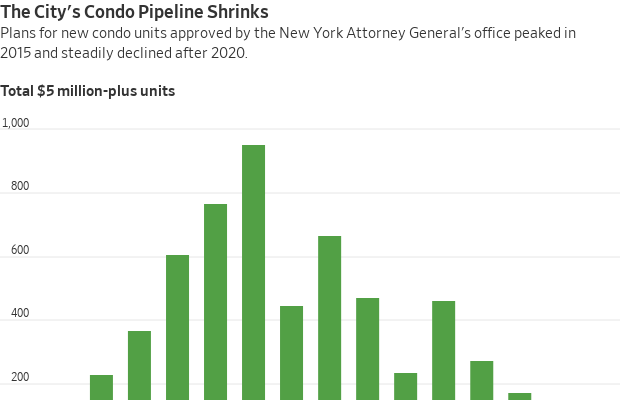
As of the close of February in Manhattan, there were close to 1,400 developer-owned units for sale at prices over $5 million, with an average asking price per square foot of $3,820, according to analytics firm MarketProof.
Outside of Midtown, neighbourhoods with significant new development inventory at that price range include West Chelsea, Lincoln Square and the Financial District. Again, that is thanks to a handful of megaprojects, including Chelsea’s One High Line and Macklowe Properties’ One Wall Street.
After a slow start marred by controversy, One High Line was among the top-selling buildings of 2023. It posted 35 closings with an average price per square foot of around $3,000, according to a spokeswoman for the developer. That brought the total number of sales to around 80, she said. Formerly known as the XI, the 235-unit condo project first launched sales in 2018, but the original developer, HFZ Capital Group, faced financial distress and the project stalled. Witkoff and Access Industries took over the project in 2022 and rebranded it.
Meanwhile, industry sources say sales have been slow at One Wall Street, the former headquarters of the Irving Trust Company bank. Sales launched at the 566-unit building in September 2021 and there were still 467 units remaining as of late February, according to MarketProof. A spokeswoman for the project didn’t respond to a request for comment.
Gary Barnett of Extell Development, the firm behind Central Park Tower, said that while “inventory is gradually getting eaten up” across the city, his company is now being “very careful to pick the right projects.”
“You don’t want to be in a situation where your cost basis is so high that you have to make $6,000 or $7,000 a foot to make money,” he said.
While he has plenty of inventory remaining on Billionaires’ Row, another of the company’s projects, 50 West 66th Street, a roughly 125-unit project off Central Park on the Upper West Side, is close to 50% sold without having even formally launched sales, he said.
Barnett pointed to the project as evidence that “if you have the right product in the right location, you can still get very real and serious prices.”
 Copyright 2020, Dow Jones & Company, Inc. All Rights Reserved Worldwide. LEARN MORE
Copyright 2020, Dow Jones & Company, Inc. All Rights Reserved Worldwide. LEARN MORE
This stylish family home combines a classic palette and finishes with a flexible floorplan
Just 55 minutes from Sydney, make this your creative getaway located in the majestic Hawkesbury region.
Ahead of the Games, a breakdown of the city’s most desirable places to live
PARIS —Paris has long been a byword for luxurious living. The traditional components of the upscale home, from parquet floors to elaborate moldings, have their origins here. Yet settling down in just the right address in this low-rise, high-density city may be the greatest luxury of all.
Tradition reigns supreme in Paris real estate, where certain conditions seem set in stone—the western half of the city, on either side of the Seine, has long been more expensive than the east. But in the fashion world’s capital, parts of the housing market are also subject to shifting fads. In the trendy, hilly northeast, a roving cool factor can send prices in this year’s hip neighborhood rising, while last year’s might seem like a sudden bargain.
This week, with the opening of the Olympic Games and the eyes of the world turned toward Paris, The Wall Street Journal looks at the most expensive and desirable areas in the City of Light.
The Most Expensive Arrondissement: the 6th
Known for historic architecture, elegant apartment houses and bohemian street cred, the 6th Arrondissement is Paris’s answer to Manhattan’s West Village. Like its New York counterpart, the 6th’s starving-artist days are long behind it. But the charm that first wooed notable residents like Gertrude Stein and Jean-Paul Sartre is still largely intact, attracting high-minded tourists and deep-pocketed homeowners who can afford its once-edgy, now serene atmosphere.
Le Breton George V Notaires, a Paris notary with an international clientele, says the 6th consistently holds the title of most expensive arrondissement among Paris’s 20 administrative districts, and 2023 was no exception. Last year, average home prices reached $1,428 a square foot—almost 30% higher than the Paris average of $1,100 a square foot.
According to Meilleurs Agents, the Paris real estate appraisal company, the 6th is also home to three of the city’s five most expensive streets. Rue de Furstemberg, a secluded loop between Boulevard Saint-Germain and the Seine, comes in on top, with average prices of $2,454 a square foot as of March 2024.
For more than two decades, Kyle Branum, a 51-year-old attorney, and Kimberly Branum, a 60-year-old retired CEO, have been regular visitors to Paris, opting for apartment rentals and ultimately an ownership interest in an apartment in the city’s 7th Arrondissement, a sedate Left Bank district known for its discreet atmosphere and plutocratic residents.
“The 7th was the only place we stayed,” says Kimberly, “but we spent most of our time in the 6th.”
In 2022, inspired by the strength of the dollar, the Branums decided to fulfil a longstanding dream of buying in Paris. Working with Paris Property Group, they opted for a 1,465-square-foot, three-bedroom in a building dating to the 17th century on a side street in the 6th Arrondissement. They paid $2.7 million for the unit and then spent just over $1 million on the renovation, working with Franco-American visual artist Monte Laster, who also does interiors.
The couple, who live in Santa Barbara, Calif., plan to spend about three months a year in Paris, hosting children and grandchildren, and cooking after forays to local food markets. Their new kitchen, which includes a French stove from luxury appliance brand Lacanche, is Kimberly’s favourite room, she says.
Another American, investor Ashley Maddox, 49, is also considering relocating.
In 2012, the longtime Paris resident bought a dingy, overstuffed 1,765-square-foot apartment in the 6th and started from scratch. She paid $2.5 million and undertook a gut renovation and building improvements for about $800,000. A centrepiece of the home now is the one-time salon, which was turned into an open-plan kitchen and dining area where Maddox and her three children tend to hang out, American-style. Just outside her door are some of the city’s best-known bakeries and cheesemongers, and she is a short walk from the Jardin du Luxembourg, the Left Bank’s premier green space.
“A lot of the majesty of the city is accessible from here,” she says. “It’s so central, it’s bananas.” Now that two of her children are going away to school, she has listed the four-bedroom apartment with Varenne for $5 million.
The Most Expensive Neighbourhoods: Notre-Dame and Invalides
Garrow Kedigian is moving up in the world of Parisian real estate by heading south of the Seine.
During the pandemic, the Canada-born, New York-based interior designer reassessed his life, he says, and decided “I’m not going to wait any longer to have a pied-à-terre in Paris.”
He originally selected a 1,130-square-foot one-bedroom in the trendy 9th Arrondissement, an up-and-coming Right Bank district just below Montmartre. But he soon realised it was too small for his extended stays, not to mention hosting guests from out of town.
After paying about $1.6 million in 2022 and then investing about $55,000 in new decor, he put the unit up for sale in early 2024 and went house-shopping a second time. He ended up in the Invalides quarter of the 7th Arrondissement in the shadow of one Paris’s signature monuments, the golden-domed Hôtel des Invalides, which dates to the 17th century and is fronted by a grand esplanade.
His new neighbourhood vies for Paris’s most expensive with the Notre-Dame quarter in the 4th Arrondissement, centred on a few islands in the Seine behind its namesake cathedral. According to Le Breton, home prices in the Notre-Dame neighbourhood were $1,818 a square foot in 2023, followed by $1,568 a square foot in Invalides.
After breaking even on his Right Bank one-bedroom, Kedigian paid $2.4 million for his new 1,450-square-foot two-bedroom in a late 19th-century building. It has southern exposures, rounded living-room windows and “gorgeous floors,” he says. Kedigian, who bought the new flat through Junot Fine Properties/Knight Frank, plans to spend up to $435,000 on a renovation that will involve restoring the original 12-foot ceiling height in many of the rooms, as well as rescuing the ceilings’ elaborate stucco detailing. He expects to finish in 2025.
Over in the Notre-Dame neighbourhood, Belles demeures de France/Christie’s recently sold a 2,370-square-foot, four-bedroom home for close to the asking price of about $8.6 million, or about $3,630 a square foot. Listing agent Marie-Hélène Lundgreen says this places the unit near the very top of Paris luxury real estate, where prime homes typically sell between $2,530 and $4,040 a square foot.
The Most Expensive Suburb: Neuilly-sur-Seine
The Boulevard Périphérique, the 22-mile ring road that surrounds Paris and its 20 arrondissements, was once a line in the sand for Parisians, who regarded the French capital’s numerous suburbs as something to drive through on their way to and from vacation. The past few decades have seen waves of gentrification beyond the city’s borders, upgrading humble or industrial districts to the north and east into prime residential areas. And it has turned Neuilly-sur-Seine, just northwest of the city, into a luxury compound of first resort.
In 2023, Neuilly’s average home price of $1,092 a square foot made the leafy, stately community Paris’s most expensive suburb.
Longtime residents, Alain and Michèle Bigio, decided this year is the right time to list their 7,730-square-foot, four-bedroom townhouse on a gated Neuilly street.
The couple, now in their mid 70s, completed the home in 1990, two years after they purchased a small parcel of garden from the owners next door for an undisclosed amount. Having relocated from a white-marble château outside Paris, the couple echoed their previous home by using white- and cream-coloured stone in the new four-story build. The Bigios, who will relocate just back over the border in the 16th Arrondissement, have listed the property with Emile Garcin Propriétés for $14.7 million.
The couple raised two adult children here and undertook upgrades in their empty-nester years—most recently, an indoor pool in the basement and a new elevator.
The cool, pale interiors give way to dark and sardonic images in the former staff’s quarters in the basement where Alain works on his hobby—surreal and satirical paintings, whose risqué content means that his wife prefers they stay downstairs. “I’m not a painter,” he says. “But I paint.”
The Trendiest Arrondissement: the 9th
French interior designer Julie Hamon is theatre royalty. Her grandfather was playwright Jean Anouilh, a giant of 20th-century French literature, and her sister is actress Gwendoline Hamon. The 52-year-old, who divides her time between Paris and the U.K., still remembers when the city’s 9th Arrondissement, where she and her husband bought their 1,885-square-foot duplex in 2017, was a place to have fun rather than put down roots. Now, the 9th is the place to do both.
The 9th, a largely 19th-century district, is Paris at its most urban. But what it lacks in parks and other green spaces, it makes up with nightlife and a bustling street life. Among Paris’s gentrifying districts, which have been transformed since 2000 from near-slums to the brink of luxury, the 9th has emerged as the clear winner. According to Le Breton, average 2023 home prices here were $1,062 a square foot, while its nearest competitors for the cool crown, the 10th and the 11th, have yet to break $1,011 a square foot.
A co-principal in the Bobo Design Studio, Hamon—whose gut renovation includes a dramatic skylight, a home cinema and air conditioning—still seems surprised at how far her arrondissement has come. “The 9th used to be well known for all the theatres, nightclubs and strip clubs,” she says. “But it was never a place where you wanted to live—now it’s the place to be.”
With their youngest child about to go to college, she and her husband, 52-year-old entrepreneur Guillaume Clignet, decided to list their Paris home for $3.45 million and live in London full-time. Propriétés Parisiennes/Sotheby’s is handling the listing, which has just gone into contract after about six months on the market.
The 9th’s music venues were a draw for 44-year-old American musician and piano dealer, Ronen Segev, who divides his time between Miami and a 1,725-square-foot, two-bedroom in the lower reaches of the arrondissement. Aided by Paris Property Group, Segev purchased the apartment at auction during the pandemic, sight unseen, for $1.69 million. He spent $270,000 on a renovation, knocking down a wall to make a larger salon suitable for home concerts.
During the Olympics, Segev is renting out the space for about $22,850 a week to attendees of the Games. Otherwise, he prefers longer-term sublets to visiting musicians for $32,700 a month.
Most Exclusive Address: Avenue Junot
Hidden in the hilly expanses of the 18th Arrondissement lies a legendary street that, for those in the know, is the city’s most exclusive address. Avenue Junot, a bucolic tree-lined lane, is a fairy-tale version of the city, separate from the gritty bustle that surrounds it.
Homes here rarely come up for sale, and, when they do, they tend to be off-market, or sold before they can be listed. Martine Kuperfis—whose Paris-based Junot Group real-estate company is named for the street—says the most expensive units here are penthouses with views over the whole of the city.
In 2021, her agency sold a 3,230-square-foot triplex apartment, with a 1,400-square-foot terrace, for $8.5 million. At about $2,630 a square foot, that is three times the current average price in the whole of the 18th.
Among its current Junot listings is a 1930s 1,220-square-foot townhouse on the avenue’s cobblestone extension, with an asking price of $2.8 million.
This stylish family home combines a classic palette and finishes with a flexible floorplan
Just 55 minutes from Sydney, make this your creative getaway located in the majestic Hawkesbury region.









